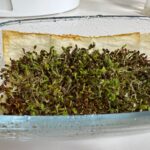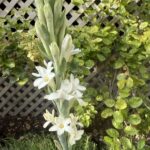As a follow-up to my Jasmine Post, here is an introduction to another beauty the Madagascar Jasmine. It is not really jasmine but has a cluster of beautiful, heavily scented flowers very akin to the fragrance of jasmine. The botanical name is Stephanotis Floribunda commonly known as Waxflower. As usual, each one of my plants has a story. This one was introduced to me by a dear friend and gardening expert who went plant shopping with me. She is fabulous at spotting interesting plants and insisted I buy this even though it was sold as an indoor plant. In the Gulf, half of the plants which do well outdoors 70 percent of the year are often sold as indoor plants. So, the next time you visit a nursery, visit the indoor section and you might find a gem or two.
So, I got persuaded to buy this plant, and it gave me gorgeous flowers for a while and then went dormant. I fertilized well and come spring it has developed new shoots and buds and I hope to see more flowers soon. The following information is from the website https://www.houseplantsexpert.com/madagascar-jasmine.html. The Madagascar Jasmine plant is commonly used for bridal bouquets and wreaths. This is because of the small white attractive blooms which match the white wedding look needed, and the stems winding around wire hoops, create a perfect wreath. Waxy white star-shaped tubular flowers appear in clusters from a peduncle and cluster of pedicles (a group of small stems each producing a flower attached to one larger stem). These can bloom at any time of the year indoors with enough light, warmth, and humidity, although they bloom most often during spring and summer, especially outdoors.
The Madagascar Jasmine can be fairly difficult to get blooming in temperate regions “indoors and outdoors”. The best chance it has of blooming is by providing it with a cool rest period during the winter and a warm and bright spring-summer, with above-average humidity. Unfortunately, you will often see these produce buds and then drop before or after turning yellow with unopened petals. Moving them to a new colder location can cause flowers to drop before blooming fully.
To have successful blooms – many growers have to work at getting the conditions just right, so don’t give up when no flowers appear straight away. The flowers will last for a few days or so. To extrapolate to the Gulf climate and my own experience, keep your Madagascar Jasmine in part shade during the season from November to April. During the months of January and February, it will go dormant and will show no new growth, however, come spring you will see new growth and buds. Make sure to fertilize and water regularly at this time and you will see flowers. Do not move from the spot, as it is temperamental and will lose its buds without opening. Once the flowers bloom, you can move the plant indoors come May and keep it in a bright spot away from the blast of the air conditioner. Remember to water only when topsoil is dry and fertilize at least once a month and you will be rewarded with blooms even inside here as long as the temperature does not go below 22 degrees centigrade. It also likes humidity so misting it or grouping it with other plants and keeping some water in bowls near it, or a humidifier will help.
It needs a well-draining soil so potting soil mixed with peat moss and perlite is ideal. It can be propagated by non-flowering stem cuttings in summer, but I would suggest September in the Gulf. Remember to give a 45-degree cut and dip in rooting hormone and plant in a covered pot so that a humidity zone is created. You can also propagate by seeds though they are hard to come by.
This plant does not need too much pruning, just deadhead dying leaves and yellow stems. It is also non-toxic to pets so a great plant to have indoors.








Recent Comments